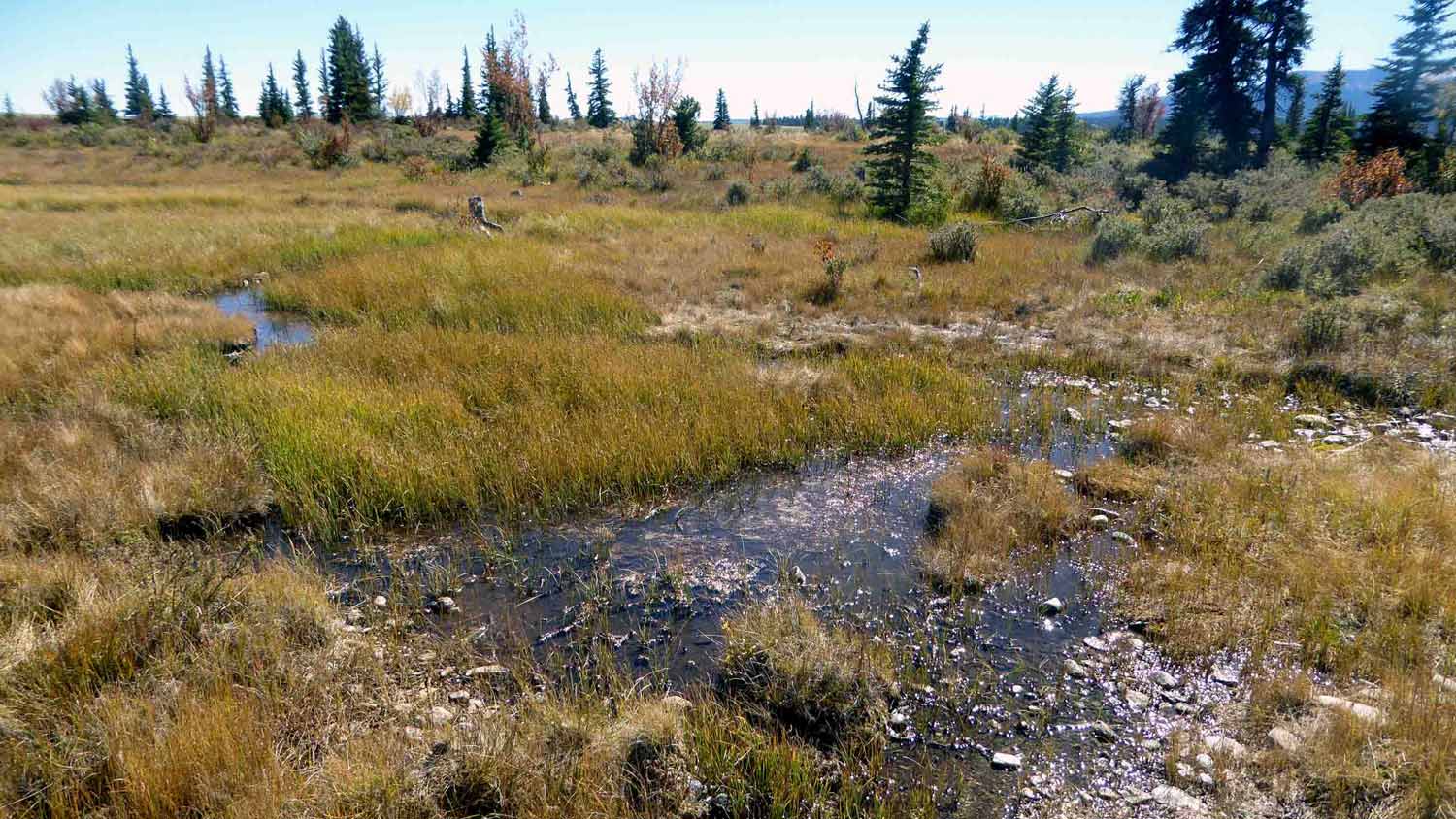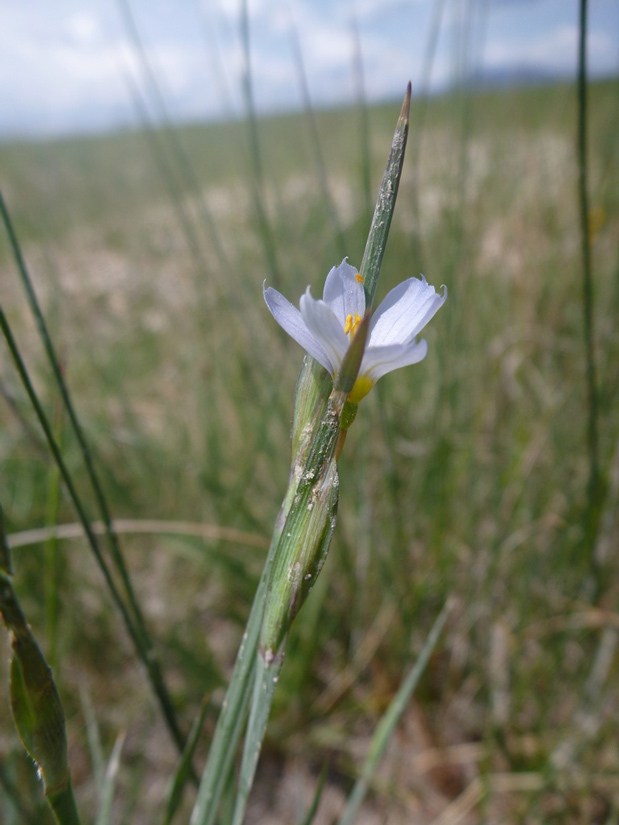Subalpine - Montane Fens
High Creek Fen, South Park, Park County
Fens
A fen (from most general to specific) is a:
- Wetland – for a site to be called a wetland, it must have soil saturation at least 2 weeks per year during the growing season, wetland soils, and plants that can tolerate saturated conditions (Tiner 2016). Wetlands occupy approximately 1.5 percent of the total landmass in Colorado. Wetlands globally include bogs, fens, marshes, and wet meadows. Wetlands besides bogs and fens are considered decomposing systems generally found on mineral soils.
- Peatland – a type of wetland that is found on deep organic soils. Peatlands are divided into bogs and fens. Bogs are generally found extensively in high moisture areas of the world (ie. Canada, Alaska). There are only fens in Colorado, no bogs, because of the dry climate (Chimner & Cooper 2003, Chimner et al. 2010).
- Fen – a groundwater-dependent ecosystem that accumulates organic matter in the form of peat. Fens have organic soils with 16 inches (40 cm) or more of peat (organic material) and 12% or more organic carbon. Of the small percentage of CO land mass occupying mountain wetlands, roughly 0.03 percent of that may be classified as fens (Cooper 2003). In the Rocky Mountains fens are rare and high value ecosystems (Winters et al. 2006). Fens have the greatest biodiversity of any wetland (Lamers et al. 2015). On the Grand Mesa, Uncompahgre & Gunnison National Forests (GMUG) fens are common in the Sawatch Mountains, Grand Mesa, eastern and middle San Juan Mountains, and Cones areas. They are uncommon in the Cochetopa, Battlement Mesa, and Uncompahgre Plateau areas (Johnston 2012). The average size of fens in the San Juan Mountains and on the GMUG is less than 4 acres (Chimner et al. 2010, Johnston et al. 2012).
Fen characteristics
- In western Colorado fens are found at sites above 9,000 feet in elevation with consistent soil saturation from groundwater discharge over thousands of years and little sedimentation or erosion. They have high biodiversity, endemic/Sensitive plants or wildlife species, uncommon plant communities, and unusual invertebrates (Cooper 1996, Winters et al. 2006, Patterson & Cooper 2007, Chimner et al. 2010).
Some Commonly Associated Plants
Click on photo to see full-page lightbox image.
In lightbox, click on X in upper right corner to return here.
Pale Blue-eyed Grass (Sisyrinchium pallidum)
Pale Blue-eyed Grass (Sisyrinchium pallidum), Iris Family (Iridaceae), native and vulnerable in Colorado and globally. Found in moist meadows and along streams, known from the south-central counties (Archuleta, Conejos, Rio Grande, Saguache), sometimes found growing with S. montanum, from foothills to montane on the eastern and western slopes. Blooms in June and July. This is a local endemic in southeastern Wyoming and north-central Colorado which is relatively abundant in this area, with 43 occurrences in Colorado. Photo by Loraine Yeatts.
- Fens are some of the oldest ecosystems in the world, especially in cold climates. In Colorado peat accumulates at approximately 8 – 11 inches per 1,000 years (Cooper 1990). On the GMUG peat depth has been documented from 7 feet deep in an iron fen to over 19 feet in the Church Camp Fen on Grand Mesa. Dr. Don Sullivan, Denver University Geographer, estimates that a few of the fens on Grand Mesa may be 18,000 – 20,000 years old (includes lake sediment below the peat mass). An iron fen in the Gunnison Basin has been carbon-dated to approximately 8,000 years old (Fall 1997). Fens are invaluable paleoecological (post-glacial) records of ancient climate history and vegetative community structure (Sullivan 2003, Johnson & Miller 2012).
- Fens act as accumulating ecosystems as opposed to decomposing systems. Fens perform key functions for carbon storage (Cooper 1996, Chimner et al. 2010).
References
References:
Austin, G. and D.J. Cooper. 2016. Persistence of high elevation fens in the southern Rocky Mountains on Grand Mesa, Colorado, U.S.A. Wetlands Ecology and Management 24:317-334.
Chimner, R.A. and D.J. Cooper. 2003. Carbon balances of pristine and hydrologically modified southern Rocky Mountain fens. Canadian Journal of Botany 81: 477 – 491.
Chimner, Rod A.; Joanna M. Lemly; and David J. Cooper. 2010. Mountain fen distribution, types and restoration priorities, San Juan Mountains, Colorado, USA. Wetlands 30(4): 763-771.
Chimner, R.A. 2011. Restoring sedges and mosses into frost heaving iron fens, San Juan Mountains, Colorado. Mires and Peat 8(7): 1-9.
Chimner, R.A., D.J. Cooper, M.D. Bidwell, A. Culpepper, K. Zillich, K. Nydick. 2018. A new method for restoring ditches in peatlands: ditch filling with fiber bales. Restoration Ecology 27(1): 63-69.
Colorado Natural Heritage Program. 1996. Potential conservation areas outside the Gunnison Basin Potential Conservation Area, Cement Creek Potential Conservation Area. Unpublished document. Pgs 102-109.
Cooper, D.J. and R. Andrus. 1994. Peatlands of the west-central Wind River Range, Wyoming: vegetation, flora and water chemistry. Canadian Journal of Botany 72: 1586 – 1597.
Cooper, D.J. 1996. Soil and water chemistry, floristics and phytocociology of the extreme rich High Creek Fen, South Park, Colorado. Canadian Journal of Botany 74:1801-1811.
Fall, P.L. 1997. Fire history and composition of the subalpine forest of western Colorado during the Holocene. Journal of Biogeography 24:309-325.
Johnson, K. and I. Miller. 2012. Digging Snowmastodon: discovering an ice age world in the Colorado Rockies. Denver Museum of Nature and Science. Denver, CO. 1-141.
Johnston, B.C., B.T. Stratton, W.R. Young, L.L. Mattson, J.M. Almy, G.T. Austin. 2012. Inventory of fens in a large landscape of west-central Colorado. Unpublished document. Grand Mesa, Uncompahgre, and Gunnison National Forests. Delta, CO.
Lamers, L.P.M., M.A. Vile, A.P. Grootjans, M.C. Acreman, R. van Diggelen, M.G. Evans, C.J. Richardson, L. Rochefort, A.M. Kooijman, J.G.M. Roelofs, and A.J.P. Smolders. 2015. Ecological restoration of rich fens in Europe and North America: from trial and error to an evidence-based approach. Biol. Rev. 90:182 – 203 pp.
Patterson, L. and D.J. Cooper. 2007. The hydrologic and ecological indicators for the restoration of drainage ditches and water diversions in a mountain fen, Cascade Range, California. Wetlands 27(2):290-304.
Schimelpfenig, D.W., D.J. Cooper, R.A. Chimner. 2014. Effectiveness of ditch blockage for restoring hydrologic and soil processes in mountain peatlands. Restoration Ecology 22: 257-265.
Sueltenfuss, J.P. and D.J. Cooper. 2019. A new approach for hydrologic performance standards in wetland mitigation. Science Direct 231: 1154-1163.
Tiner, R.W. 2016. Wetland indicators: a guide to wetland formation, identification, delineation, classification, and mapping. 2nd ed. CRC Press, Boca Raton.
USDI Fish and Wildlife Service, Region 6. 1999. Peatland mitigation policy considerations. Ecological Services, Colorado Field Office. Lakewood, CO.
Winters D., B. Bohn, D.J. Cooper, G. Eaglin, J. Hamerlink, C. Hirsch, N.L. Poff, C. Quimby, F. Rahel, D. Scaife, D. Staley, M. Welker, E. Wohl. 2003. Conceptual framework and protocols for conducting broad scale aquatic, riparian, and wetland ecological assessments. U.S. Department of Agriculture, Forest Service, Rocky Mountain Region, Lakewood, 147 pp.
- Fens maintain greater capacity for heavy metal absorption than wetlands because they are accumulating systems not decomposing ones.
- Fen characteristics are determined by the mineral and chemical content of the groundwater. Fens are extremely sensitive to changes in water chemistry and water quantity (Chimner & Cooper 2003, Patterson & Cooper 2007, Chimner et al. 2010).
Fen types of Colorado:
Chimner (2010) documented rich fens and uncommon iron fens in the San Juan Mountains. Fens on the GMUG NF were classified into landform categories of topogenous (depressions and basins) and soligenous (sloping and toeslope) fens (Johnston 2012) and peat chemistry categories (Austin & Cooper 2016). Extreme rich fens, globally imperiled (G2) peatlands, exist in South Park (Cooper 1996) and the Gunnison Basin (CNHP 1996).
Key fen components sensitive to damage/loss:
1. Groundwater with soil saturation throughout the year.
2. Organic soil/peat accumulation.
3. Peat-forming plants.
4. Rare plants/plant communities dependent on fens.
Threats from human activities:
Water development (flooding, ditches, de-watering, soil removal, sedimentation), recreation use, timber management, land and minerals management (ie. pipelines). To a lesser extent, grazing management (Johnston et al. 2012, Austin & Cooper 2016). Fens, especially isolated fen communities, are not protected under the revised Clean Water Act (2020) changes.
Research efforts to restore fens in Colorado have been occurring for 23 years (Cooper et al. 1998) and are on-going (Chimner 2011, Schimelpfenig et al. 2014, Cooper et al. 2017, Chimner et al. 2018). The primary focus is restoring the hydrology of damaged fens and secondly, allowing peat-forming plants such as sedges (CAREX) to recolonize sites (Sueltenfuss & Cooper 2019).
– Gay Austin

